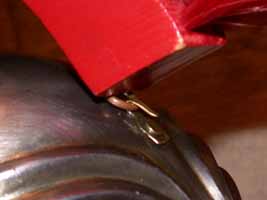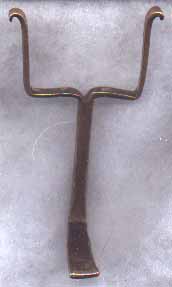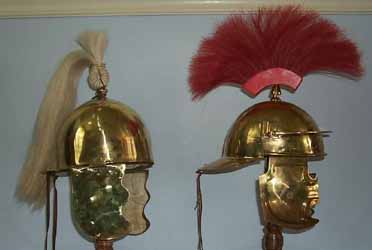LEGIO XX ONLINE HANDBOOK
HELMET CRESTS
10/12/06
----------
*Home*Handbook Intro*Tunic*Caligae*Cloak*Belt*Helmets*Segmentata*Hamata*Squamata*Subarmalis*Scutum*Gladius*
*Pilum*Pugio*Packs*Mess
Gear*Tools*Crests*Drill*Leatherworking*Armoring*
----------
 |
There are depictions of
helmet
crests and a few descriptions, but almost no surviving examples or
fragments
(besides the metal attachments). It is believed that crests were
not worn in battle in our period except by centurions. Legio XX
has
chosen red for the color of our crests, though they may be of different
styles. The first type described is for Imperial-style
helmets. (Photo at left copyright Jane Walker.)
The crest block is wood,
c. 1-1/2"
wide by 1-1/4" thick in height. (It can be cut from a nice
2x6.)
The exact size and shape depend on your helmet and preferences, but it
is approximately semi-circular. The ends should not quite touch
the
helmet at the attachment points at front and back, and the center is
1-1/2"
to 2" above the crown, supported by the crest support. The
placement
of the central support and its holder will also influence the crest's
shape.
(For instance, is the support inserted into the front of the holder or
the rear?) Make a cardboard pattern first to be sure of the
shape.

|
 |
Cut the block out
carefully and
sand it well. Mark the locations for the holes, 1/4" in diameter,
1/4" apart (1/2" on center), and c. 3/8" deep. Three staggered
rows
work well. There can be about 100 holes. Drill them
carefully,
as the wood grain may cause the drill to drift off-target. When
the
holes are done, sand the top of the block again and paint the whole
thing
red.
| Before installing
the hair or
feathers, add the fittings for securing the crest to the helmet.
A small ring at each end, held by a folded strip of brass which is
nailed
to the underside of the block, can be connected directly to a hook on
the
helmet, or tied to a ring (or hook). |
 |
|
The only evidence for decorated
crest blocks comes from sculptures of officers such as on the
Cancelleria
relief, so if you want to add decoration you can discuss options with
the
Commander. There does not seem to be any solid evidence that the
Romans used striped or multi-colored crests.
Horsehair can be purchased from
leather companies such as those listed on the Suppliers
page. About 8 ounces of white horsehair is needed. (One
ounce
will make 12 to 14 twelve-inch tufts.) It usually
comes
about 24" long, so start by cutting it to about 12" long.
Separate
the hair into four or six bundles tied tightly in the middle, and dye
it
red with Rit Scarlet fabric dye in a large kettle on the stove.
Follow
the directions, making sure to keep gently stirring and moving the
hair,
and not allowing it to get too hot, or it may curl and frizz.
About
half an hour should get a deep enough red color. Do not
substitute
leather dye as it is not waterproof! Lay the hair flat and
straight
to dry. When dry, separate the hair into as many little tufts as
there are holes in your block, and tie each tuft in the center with
heavy
thread. Don't worry about the white middles of the strands.
Fold each tuft in half and glue it into a hole, using hide glue,
Elmer's
Carpenter glue, or equivalent. When the glue is dry, comb the
hair
gently with a fork or coarse comb and give it a light trim.
When finished, the hair will
stand
up 5" or 6" tall, and it should be stiff enough to stand up
nicely.
But always store the crest laying flat or (better yet) hanging
upside-down.
If you leave it displayed on your helmet while not in use, the hair
will
droop.
Feathers can be used instead of
horsehair, and red ones are available from leather and craft
stores.
They may have to be trimmed a couple inches. If your helmet has
feather
tubes at the sides you may wear a feather in each of them, no matter
what
your crest is made of.
 |
The crest support for an
Imperial-Gallic
helmet can be cut from a square-section 1/4" brass or steel rod 5" to
6"
long. Make a 2" cut in one end with a hacksaw, and bend the arms
down to a T-shape. Then bend up each arm so that your crest block
fits between them, and finish the tips by curling them down.
Anneal
the metal before each step. Making sure that the center post is
the
right height to support the crest where you want it, bend the bottom
end
to form the foot or tongue, and grind or hammer it flat to fit the
holder
on your helmet. Finally, file, sand, and polish it well.
The
arms can be squeezed together slightly at the top to give them a firm
grip
on the crest block.
Crest supports made of brass
are apparently
more common finds than iron, but quarter-inch square steel stock is
readily
available and easier to work. Brass must be annealed and allowed
to cool, often more than once to make each bend, to avoid cracking or
breaking;
steel can be worked hot or cold with very little chance of
breakage.
See the Armoring Hints page for more
information.
|
Imperial-Italic helmets have
"twist-on"
supports, usually cast: a T-shaped stud on the bottom fits into
the
slotted disc on the helmet and secures with a quarter-turn. Some
have a spike between the arms which would fit into a hole in the crest
block--this could be secure enough to dispense with hooks or rings.
Many depictions show a
comparatively
short block mounted directly on the helmet. Judging by the
archeological
evidence this would not be the most common style, but a U-shaped
support
with a T-stud on the bottom has been found. This would result in
a "flush-mounted" crest similar to those illustrations, and is an
option
for some Italic helmets.
 |
Coolus helmet
crest knobs often
have a slot crossed by a hole. A metal tongue on the bottom of
the
crest block (or set into a conical hole) fits into the slot and is
secured
by a pin. The crest block would be quite short in this case. |
There is also evidence
that some
Coolus helmets carried a longer crest (c. 1/3 of a circle), anchored to
the knob near its front end, while at the back a metal tongue was slid
under a strip riveted to the skull just above the neckguard.
Montefortino helmets
generally
have a knob with a vertical hole. While a Coolus-style crest
could
be "retro-fitted" to this, it was designed to accept a pin on a simple
plume or "tail" of horsehair. This is acceptable for Legion use
as
long as it is red. Four or five ounces of horsehair, 24 inches
long,
is needed.
|
 |

|
Detail of the Montefortino crest knob and horsehair "tail" shown
above. Heavy linen thread is wrapped around the hair and glued,
then the wire is wrapped around, the end pointing down through the
bundle to form the pin. The thin leather cord is tied around the
knob to secure the crest. At right is the base of a Punic War-era
feather crest, three black and purple feathers, similarly bound with
wire which forms a pin.
|
While you will probably want to
display your crest when not in use, it is better to store it
carefully.
It is the one item of equipment which should NOT show wear and tear
from
campaigning. Keeping it covered and laid flat--or better yet,
suspended
upside-down--will keep off dust and prevent drooping. The best
option
is to construct a sturdy cardboard box with strings or wire twist-ties
inside to keep the crest from sliding around. Make a place for
the
crest holder, too.
Some fragments of what were
apparently
feathers were found with the Corbridge Hoard, and it is possible that
these
were from a helmet crest. More interestingly, a piece of what
seems
to be a crest was found at Vindolanda, made of a local type of moss
called
hair moss--http://www.vindolanda.com/html/previous_news_late2001.html.
(It is not necessarily from a centurion's helmet, though the fort is an
auxiliary site and the common troops may not have worn crests.)
Custom armorers such
as Lonely Mountain
Forge and Manning
Imperial are the best bet for a good crest.
Unfortunately, the crests made by Deepeeka for their helmets are not
acceptable,
being too narrow, with the hair glued into metal crest boxes.
There
have been reports of the hair coming loose, as well.
----------
*Home*Handbook Intro*Tunic*Caligae*Cloak*Belt*Helmets*Segmentata*Hamata*Squamata*Subarmalis*Scutum*Gladius*
*Pilum*Pugio*Packs*Mess
Gear*Tools*Crests*Drill*Leatherworking*Armoring*
----------
*Home*Schedule*Handbook
*Auxiliaries *Civilian
Clothing *Cold-Weather Clothing *Signum*LINKS*SUPPLIERS*Bibliography
*
*ADLOCVTIO*Tent
and Camp *Roman Days*History*Names
*Advice
on Starting a Group *PHOTOGRAPHS*Bylaws
*Membership*







